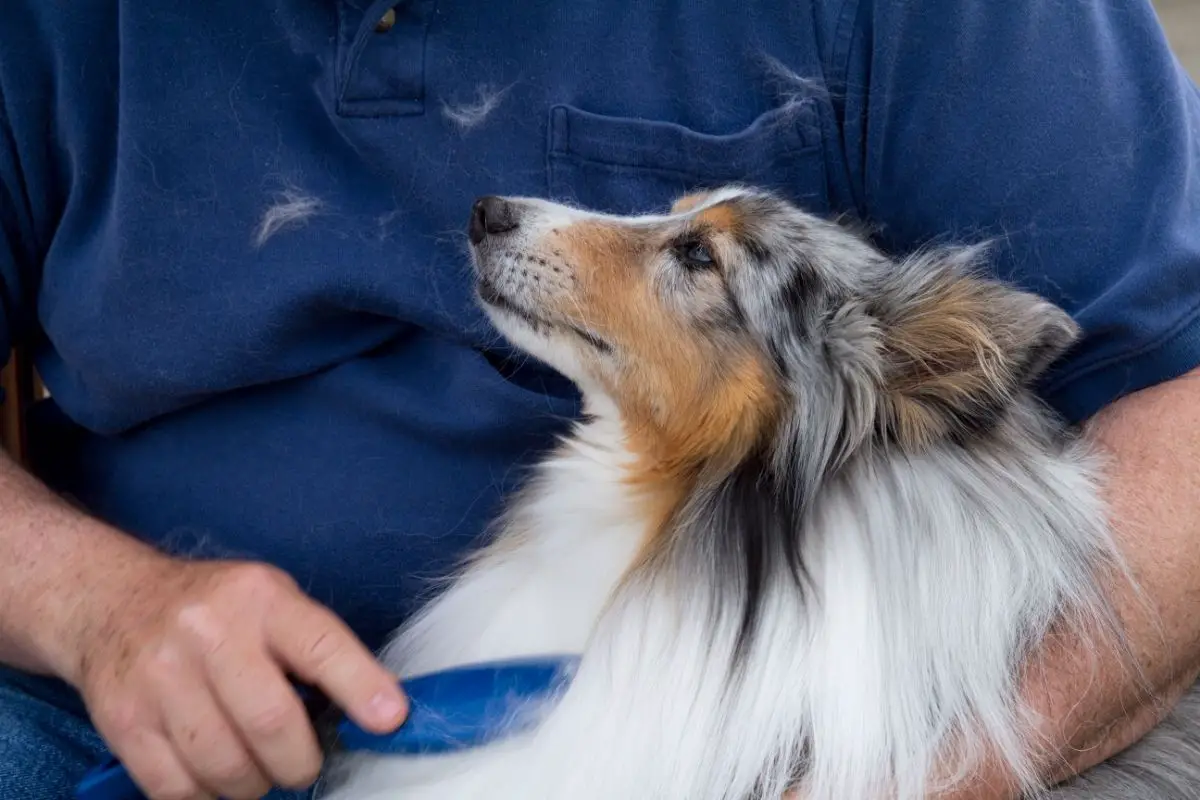Dogs are known for their loyalty, companionship, and adorable personalities. However, one aspect that can be less desirable is their tendency to shed. Shedding is a natural process for dogs, but it can become excessive in certain situations. One question that often arises is whether dogs shed when stressed.

Stress can affect dogs in various ways, and shedding is one of them. When a dog is stressed, their body releases cortisol, a hormone that can cause hair loss and shedding. This shedding is often more noticeable than the normal shedding that occurs throughout the year. While stress-induced shedding is not harmful to the dog, it can be frustrating for owners who have to deal with the excess hair.
It is important to note that stress-induced shedding is not the only reason why a dog may shed excessively. Other factors such as diet, health issues, and breed characteristics can also contribute to shedding. Therefore, it is crucial to identify the underlying cause of excessive shedding to ensure that the dog receives the appropriate treatment.

Understanding Canine Stress
Signs of Stress in Dogs
It's important for dog owners to recognize the signs of stress in their pets. Some common signs of stress in dogs include:
- Panting excessively
- Whining or whimpering
- Trembling
- Shaking
- Hiding or cowering
- Aggressive behavior
- Excessive barking or howling
- Loss of appetite
- Lethargy
Physiology of Stress in Canines
When a dog is stressed, the body releases stress hormones such as cortisol and adrenaline. These hormones prepare the dog for a fight or flight response. In the wild, this response would help the dog survive a dangerous situation. However, in domesticated dogs, this response can be triggered by everyday stressors such as loud noises, unfamiliar people, or changes in routine.
Chronic stress can have negative effects on a dog's health, including:
- Weakened immune system
- Digestive issues
- Skin problems
- Behavioral issues
- Decreased lifespan
It's important for dog owners to manage their pets' stress levels to ensure their overall health and well-being. This can be done through regular exercise, socialization, and providing a safe and comfortable environment for the dog.
Shedding in Dogs
Dogs are known for their shedding, which is a natural process of hair loss that occurs in all dogs. Shedding is a normal part of a dog's life cycle and is influenced by various factors.
Normal Shedding Patterns
Dogs shed year-round, but the amount and frequency of shedding vary depending on the breed, age, health, and season. Most dogs shed twice a year, during the spring and fall seasons, which is known as seasonal shedding. During this time, dogs shed their undercoat to prepare for the upcoming weather changes.
In addition to seasonal shedding, dogs also shed their hair regularly as part of their natural hair growth cycle. The growth cycle consists of three phases: anagen (growth), catagen (transition), and telogen (resting). During the telogen phase, the hair falls out and is replaced by a new hair. The length of each phase varies depending on the breed and individual dog.
Factors Affecting Dog Shedding
Several factors affect a dog's shedding patterns, including breed, age, health, and nutrition. Dogs with double coats, such as Huskies and Golden Retrievers, shed more than dogs with a single coat, such as Poodles and Bichon Frises. Older dogs shed less than younger dogs, and dogs with skin conditions or allergies may shed more than healthy dogs.
Nutrition also plays a role in a dog's shedding patterns. A balanced diet with essential nutrients, such as omega-3 fatty acids and biotin, can help improve a dog's skin and coat health, reducing shedding. On the other hand, a poor diet can lead to dry, itchy skin, and excessive shedding.
In conclusion, shedding is a natural process for all dogs, and the amount and frequency of shedding vary depending on various factors. By understanding the normal shedding patterns and factors affecting shedding, dog owners can better manage their dog's shedding and maintain their skin and coat health.
The Link Between Stress and Shedding
Stress-Induced Shedding
Dogs are known to shed their fur, but did you know that stress can also be a factor in shedding? When a dog is stressed, it can cause its body to release a hormone called cortisol, which can affect the natural growth cycle of their fur. This can lead to increased shedding and even hair loss in some cases.
Stress-induced shedding can be caused by a variety of factors, including changes in the dog's environment, separation anxiety, and even illness. In some cases, the shedding may be temporary and will stop once the dog's stress levels have decreased. However, in other cases, the shedding may continue until the underlying cause of the stress has been addressed.

Research on Stress and Shedding
Studies have been conducted to better understand the link between stress and shedding in dogs. One study found that dogs who were exposed to loud noises and other stressful stimuli had higher levels of cortisol in their bodies, which led to increased shedding. Another study found that dogs who experienced separation anxiety had higher levels of cortisol and shed more than dogs who did not experience separation anxiety.
While more research is needed to fully understand the link between stress and shedding in dogs, it is clear that stress can have a significant impact on a dog's fur. It is important for dog owners to be aware of the signs of stress in their pets and to take steps to reduce stress levels when possible. This can include providing a calm and comfortable environment, engaging in regular exercise and playtime, and seeking the advice of a veterinarian if necessary.
Managing Stress-Related Shedding
When dogs experience stress, they may shed more than usual. This shedding can be frustrating for owners, but there are ways to manage it. By reducing stress in dogs and using grooming techniques for shedding control, owners can keep their homes cleaner and their dogs healthier.
Reducing Stress in Dogs
Reducing stress in dogs can help to minimize shedding. One way to do this is to create a calm and relaxing environment for the dog. This can be achieved by providing a comfortable bed, toys, and a quiet space for the dog to retreat to when feeling stressed. Additionally, owners can try to identify and eliminate sources of stress, such as loud noises or unfamiliar people.
Another way to reduce stress is through exercise. Regular exercise can help to reduce anxiety and promote relaxation. Owners should aim to provide their dogs with daily exercise, such as walks or playtime in the yard.
Grooming Techniques for Shedding Control
Grooming can also help to control shedding in stressed dogs. Regular brushing can help to remove loose fur and prevent matting. Owners should use a brush that is appropriate for their dog's coat type, and should brush in the direction of hair growth.
Bathing can also help to control shedding, but should not be done too frequently as it can dry out the dog's skin. Owners should use a gentle shampoo and conditioner, and rinse thoroughly to remove all soap residue.
In addition to brushing and bathing, owners can also consider using a shedding tool. These tools are designed to remove loose fur and can be especially helpful for dogs with thick coats.
By managing stress and using grooming techniques, owners can help to control shedding in their dogs. With patience and consistency, owners can keep their homes cleaner and their dogs healthier.
When to See a Vet
If a dog is shedding excessively due to stress, it is important to monitor the situation closely. In some cases, shedding may be a sign of an underlying medical condition, which will require veterinary attention. Here are some signs to look out for:
Identifying Excessive Shedding
If a dog is shedding more than usual, it may be a sign of excessive shedding. This can be identified by observing the amount of hair that is being shed, as well as the frequency and duration of shedding. If a dog is shedding excessively, it may also have bald patches, which can be a sign of a more serious underlying condition.

Medical Conditions Related to Shedding
Some medical conditions can cause excessive shedding in dogs. These include allergies, skin infections, hormonal imbalances, and thyroid problems. If a dog is shedding excessively and is also experiencing other symptoms such as itching, redness, or inflammation, it may be a sign of an underlying medical condition. In such cases, it is important to seek veterinary attention as soon as possible.
In summary, if a dog is shedding excessively due to stress, it is important to monitor the situation closely. If the shedding persists or is accompanied by other symptoms, it may be a sign of an underlying medical condition, which will require veterinary attention.
Conclusion
In conclusion, understanding the correlation between stress and shedding in dogs is crucial for maintaining their overall health and well-being. While shedding is a natural process, stress can exacerbate it, leading to increased shedding and potential hair loss.
By recognizing the signs of stress in dogs and implementing effective stress-reducing strategies, such as providing a consistent routine, regular exercise, and grooming, pet owners can help alleviate stress-related shedding. Additionally, consulting with a veterinarian for guidance and support is essential, especially if stress-related shedding persists or is accompanied by other concerning symptoms.
By prioritizing your dog's mental and physical health and taking proactive measures to manage stress, you can ensure that your furry friend remains happy, healthy, and comfortable.
Frequently Asked Questions
Here are some common faqs about dogs shedding when stressed:
- Q1: What triggers excessive shedding in dogs?
- A1: Excessive shedding in dogs can be triggered by various factors such as changes in the environment, hormonal imbalances, poor nutrition, and stress. Shedding is a natural process that helps dogs get rid of old or damaged fur and grow new ones. However, when shedding becomes excessive, it could be a sign of an underlying problem.

- Q2: How can you tell if a dog is shedding due to stress?
- A2: Shedding due to stress can be identified by observing the dog's behavior and environment. If a dog is shedding excessively and also showing signs of anxiety such as restlessness, panting, and pacing, it could be due to stress. Additionally, changes in the dog's environment such as a move to a new home or the introduction of a new pet can also trigger stress and excessive shedding.
- Q3: What are effective methods to alleviate stress in dogs?
- A3: There are several effective methods to alleviate stress in dogs such as regular exercise, providing a comfortable and safe environment, training and socialization, and using calming aids such as pheromone sprays or supplements. It's important to identify the cause of stress and address it appropriately to prevent excessive shedding and other health issues.
- Q4: Can a sudden increase in shedding indicate a stressed dog?
- A4: Yes, a sudden increase in shedding can indicate a stressed dog. Stress can affect a dog's immune system, leading to an increase in shedding and other health issues. It's important to monitor changes in a dog's shedding patterns and behavior to identify any underlying problems.
- Q5: What are the common signs of anxiety and stress in dogs?
- A5: Common signs of anxiety and stress in dogs include excessive barking, destructive behavior, restlessness, panting, pacing, loss of appetite, and aggressive behavior. It's important to address these signs promptly to prevent further health issues.
- Q6: How does illness affect a dog's shedding patterns?
- A6: Illness can affect a dog's shedding patterns by causing hormonal imbalances, skin infections, and other health issues. Dogs with underlying health problems may shed excessively or have changes in their fur texture or color. It's important to monitor a dog's shedding patterns and seek veterinary care if there are any concerning changes.